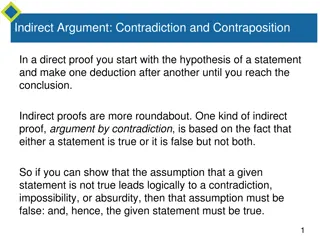
Effective Structure for Oral Argument Delivery in Legal Presentations
Learn how to organize oral arguments efficiently by addressing critical issues, structuring arguments logically, and emphasizing strong points first. Understand the importance of choosing the right order of claims to maximize impact in limited time.
Download Presentation

Please find below an Image/Link to download the presentation.
The content on the website is provided AS IS for your information and personal use only. It may not be sold, licensed, or shared on other websites without obtaining consent from the author. If you encounter any issues during the download, it is possible that the publisher has removed the file from their server.
You are allowed to download the files provided on this website for personal or commercial use, subject to the condition that they are used lawfully. All files are the property of their respective owners.
The content on the website is provided AS IS for your information and personal use only. It may not be sold, licensed, or shared on other websites without obtaining consent from the author.
E N D
Presentation Transcript
Sixth Annual Middle East Vis Pre-Moot Training Structure of Oral Argument Body, Rebuttal, and Surrebuttal 1
ORGANIZING THE ARGUMENT Plan Carefully Oral Argument is NOT the time to argue every single issue (you already did that in your memo) Rather, it is a time to address the most critical issues, in an order that is most beneficial to your client 2
ORGANIZING THE ARGUMENT Overall Structure Example: Introduction (with the hook or theme) Roadmap First Issue IRAC (Strongest to weakest) Second Issue IRAC (Strongest to weakest) [Third Issue, if necessary] [IRAC] [(Strongest to weakest)] Conclusion Rebuttal (CL) or Surrebuttal (R) 3
ORGANIZING THE ARGUMENT QUESTION Your Client has made three claims: Claim 1 is worth $500K. Claim 2 is worth $1.8M. Claim 3 is worth $1.2M. You only have 15 minutes to present your case. Which claim do you start with? 4
ORGANIZING THE ARGUMENT ANSWER If you choose to start with a claim other than the one worth the most money to your client, you must be able to explain quickly and clearly to the Arbitrators why you have done so. Valid reasons might include that the outcome of Claim 1 will determine the outcome of Claim 2, and therefore must be considered first; or, that in Claim 3 time is of the essence, and so your client wishes that matter to be settled first; etc. and so on.
ORGANIZING THE ARGUMENT In addition to dealing with claims in the order most beneficial to your client, you should structure your arguments in the order most logical: Start with your strongest arguments under each claim or issue; Then, apply the weaker arguments; Finally, dispose of counter-arguments. By starting with the strongest argument first (i.e., the one most supported by law and fact), you are increasing your odds of success in case you should run out of time before addressing secondary arguments and counter-arguments. 6
ORGANIZING THE ARGUMENT Deliver your arguments the same way you wrote the memo: Issue Rule Application Conclusion Remember to provide signposts/signals for complex arguments! 7
ORGANIZING THE ARGUMENT A Special Note to the Respondent: Your job is simply to respond to the Claimant. Therefore, organize your argument following the structure that the Claimant followed in order to maximize your responsiveness to each issue. Keep your Roadmap flexible If you deviate from responding in the order the Claimant presented its claims, explain to the Arbitrators your logic and reasons for doing so. 8
ORGANIZING THE ARGUMENT Using authority Some authorities will support your arguments more than others. Just as you would make your strongest arguments first, cite your strongest authorities first as well. Cite to weaker authorities only if you move on to weaker arguments. Know the critical information about important cases: Facts, holding, jurisdiction, precedential effect Be fully prepared to explain how each authority you cite supports your argument (Arbitrators do ask!). 9
REBUTTAL AND SURREBUTTAL CLAIMANT: You must reserve time for a rebuttal. In general, you should reserve no more than 1 minute RESPONDENT: You must reserve time for a surrebuttal. This should also be no more than 1 minute. Failing to reserve your time for rebuttal or surrebuttal up front may indicate that you have waived the opportunity, and the Arbitrators may dock you points (even if they provide time for a rebuttal). 1 0
REBUTTAL AND SURREBUTTAL Rebuttal and Surrebuttal are two of the most difficult parts of oral argument to master. Claimant should ALWAYS rebut the Respondent s argument. Respondent may waive its surrebuttal if the Claimant failed to deliver an argument in its rebuttal. 1 1
REBUTTAL AND SURREBUTTAL Content of Rebuttal: Claimant should pay close attention to Respondent s argument, and take notes of what it would like to respond to. Rebuttal must be entirely responsive; no new arguments may be raised. Rebuttal should be limited to one key point (at the very most, two). Avoid simply restating your argument; instead, offer a salient counter-argument to one of the Respondent s points. Rebuttal should be short and strong. 1 2
REBUTTAL AND SURREBUTTAL Content of Surrebuttal: Only address what was raised in rebuttal. No new arguments, or arguments not mentioned in rebuttal, may be raised in surrebuttal. A good surrebuttal is a brief but pointed counter-argument to the rebuttal, going no further than to strike down the Claimant s rebuttal. If the Claimant failed to make a good rebuttal, it can be quite effective to waive the surrebuttal: Respondent rests on its submissions. 1 3






















